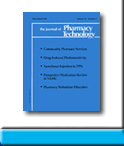 |
 |
Eptifibatide-Induced Thrombocytopenia and
Subsequent Thrombosis
Christopher Giuliano, Stephanie B Edwin, Hani Kador, and Marjorie Mooney
To request full article click here.
Objective: To report a case of thrombocytopenia and thrombosis associated with the administration of eptifibatide.
Case Summary: We describe the case of a 63-year-old male who developed thrombocytopenia and thrombosis associated with eptifibatide administration. Eptifibatide (2 μg/kg/min, following a 180-μg/kg bolus) was administered on hospital day 5, with a baseline platelet count of 302 × 103/μL. Ten hours after eptifibatide initiation in the catheterization laboratory, the patient experienced new-onset hypotension, shortness of breath, and tachycardia. Computed tomography angiography revealed bilateral, multilobar, pulmonary emboli. Platelet count decreased to 94 × 103/μL. Eptifibatide was discontinued and lepirudin 16.5 mg/h was administered because of high suspicion of heparin-induced thrombocytopenia (HIT). The platelet count returned to 127 × 103/μL on day 7. Heparin-induced platelet aggregation assay and antiplatelet factor 4 antibodies were negative. Eptifibatide-dependent platelet-reactive antibodies were detected in the patient’s serum. The patient’s platelet count continued to rise until day 16, when the patient was discharged on enoxaparin and warfarin.
Discussion: Eptifibatide-associated thrombocytopenia has been described in several case reports, but concomitant thrombosis has been reported in only 2 cases. The Naranjo probability scale suggested a probable association between eptifibatide administration and the development of thrombosis and thrombocytopenia. Our patient also developed positive eptifibatide antibodies and had a negative HIT workup. These factors, in addition to the patient’s clinical presentation, suggested that eptifibatide was the most likely cause of thrombocytopenia and thrombosis.
CONCLUSIONS: Despite the low incidence of thrombocytopenia and subsequent thrombosis with eptifibatide administration, it is imperative that patients receiving this drug have careful monitoring of their platelet count. If patients develop a profound thrombocytopenia in the setting of eptifibatide administration, we recommend evaluation for venous thromboembolism until further information is available about this adverse drug reaction.
J Pharm Technol 2012;28:146-50
To request full article click here.
|
|
|
||
|

